[url=http://www.flickr.com/photos/67856223@N06/6268972357/]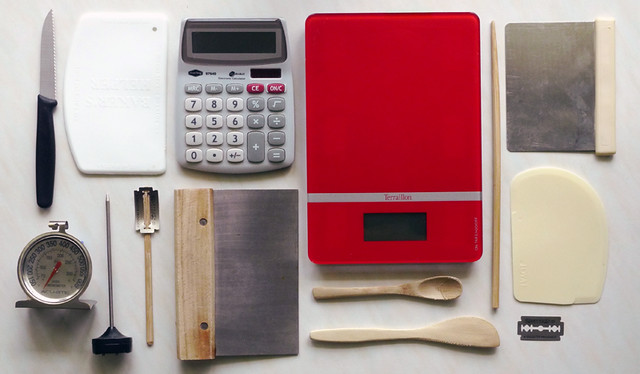 [/url]
[/url]
Saturdays are my day of play in the kitchen. I rise early in our quiet house to bake bread for the week. A boiled kettle, a cup of tea, then I start mixing and planning my day just as the sun pokes through the kitchen window. After mixing, we enjoy a lazy breakfast while I watch the dough and wait. By midday the baking is done, enticing me to cut a slice (or two) for lunch.
Last weeks Dark Rye disappointment also fuelled a rye test bake, but I will save that for another post in the next few days as I am waiting for the crumb to set.
With the rye bake keeping me busy both mentally and physically in the kitchen, I decided to be kind on myself and bake a simple adaptation of the country bread with two starters by using a proportion of wholemeal spelt in the final dough. I think I have found a winner both with flavour and texture.
Milling and Sifting
[url=http://www.flickr.com/photos/67856223@N06/6270364570/]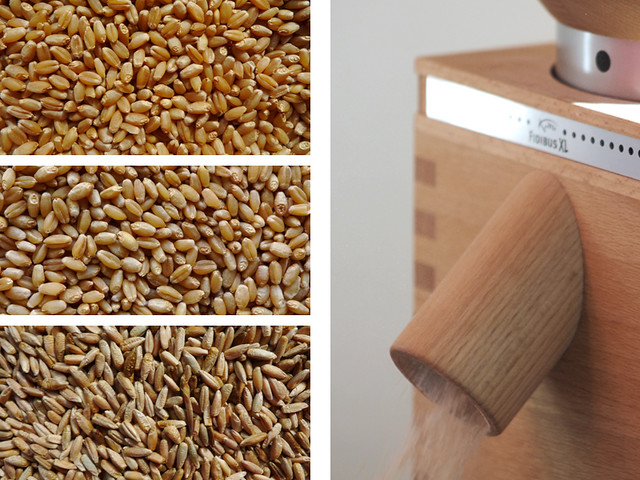 [/url]
[/url]
[url=http://www.flickr.com/photos/67856223@N06/6269498514/]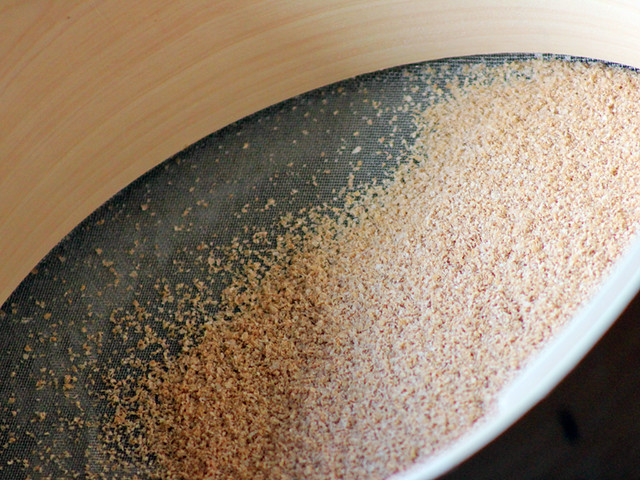 [/url]
[/url]
While last weeks light rye was certainly delicious and moist (with the soaked cracked rye) I found the sharp flavour of using only the rye starter too assertive. The overnight rise in the fridge compounded this further and the sourness became quite pronounced a few days after baking. Using a combination of the two starters and a room temperature proof seems to restore a balance that I felt was lacking in last weeks bread.
I prepared the flour the night before. The wheat was milled and sifted. The caught material was remilled and sifted again before being used in the final flour with the caught bran set aside. The spelt was milled and then added to the final flour mix without sifting while the rye grains were milled coarsely and fed to a hungry rye starter for use in the morning. My usually wholewheat starter was fed sifted wholewheat and 30% wholemeal spelt before being mixed to a 50% hydration and placed in a cool spot overnight.
3 grain country bread with two starters
[url=http://www.flickr.com/photos/67856223@N06/6268974701/]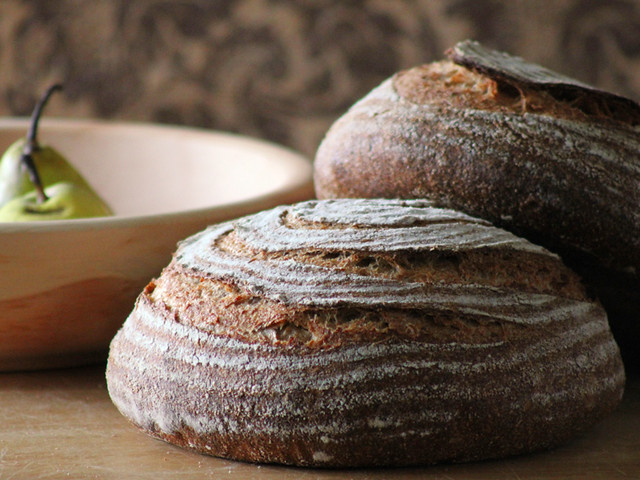 [/url]
[/url]
Formula
Overview | Weight | % |
Total flour | 1100g | 100% |
Total water | 900g | 82% |
Total salt | 25g | 2.3% |
Prefermented flour | 167g | 15% |
Desired dough temperature 23°-24°C |
|
|
|
|
|
Final dough |
|
|
Rye starter @110% hydration | 115g | 12% |
Sifted wholewheat starter @ 50% hydration | 168g | 18% |
Sifted wholewheat flour | 603g | 65% |
Wholemeal spelt flour | 330g | 35% |
Water | 784g | 84% |
Salt | 25g | 2.6% |
Last fold, shape and proof
[url=http://www.flickr.com/photos/67856223@N06/6268973035/] [/url]
[/url]
[url=http://www.flickr.com/photos/67856223@N06/6268973299/]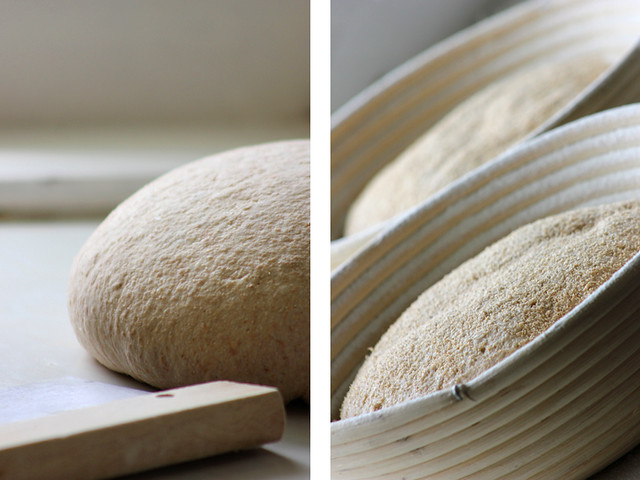 [/url]
[/url]
Method
- Autolyse flour and water for one hour.
- Incorporate starters by squeezing into dough with wet hands until smooth and feel no lumps then knead for 5 mins (I used a gentle slap and fold because of the amount of spelt). Rest dough for five mins. Incorporate salt and knead for a further five mins.
- Bulk ferment three hours with three stretch and folds 30min apart in the first 1.5hrs.
- Preshape. Bench rest 20 mins. Shape.
- Final proof was roughly two hours at room temperature (23°).
- Bake in preheated dutch oven for 10 mins at 250°C then a further 10 mins at 200°C. I then removed it from dutch oven and baked for a further 25 mins directly on stone for even browning.
This is such pleasant dough to work with. Spelt and rye bran are flecked throughout. The kneading and folding gives strength so the shaped loaves hold themselves proudly before being placed in bannetons.
[url=http://www.flickr.com/photos/67856223@N06/6269499624/]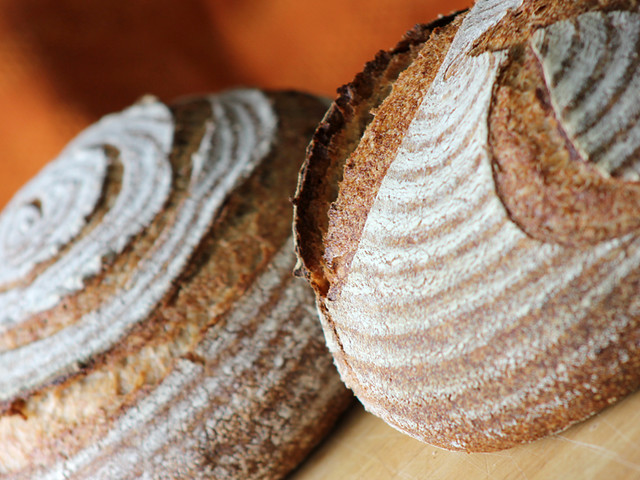 [/url]
[/url]
[url=http://www.flickr.com/photos/67856223@N06/6270376864/]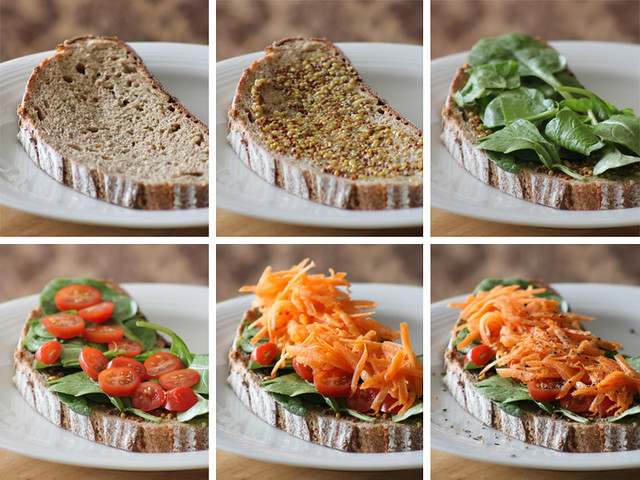 [/url]
[/url]
I had massive oven spring considering the amount of freshly milled wholemeal flours … the “Pip” was very pleased.
I played again with the scoring this week. My partner’s nickname is “Rat” so in her ratty honour I scored one of the loaves with a giant “R” … the “Rat” was very pleased.
The flavour for me is a balance between the tang in the rye and subtleness of a wheat starter. This not a boring bread, but it does not dominate the senses either.
… and after a busy day in the kitchen I prepared a simple lunch before we headed outside to continue the rest of our day in the spring sunshine.
[url=http://www.flickr.com/photos/67856223@N06/6269499344/]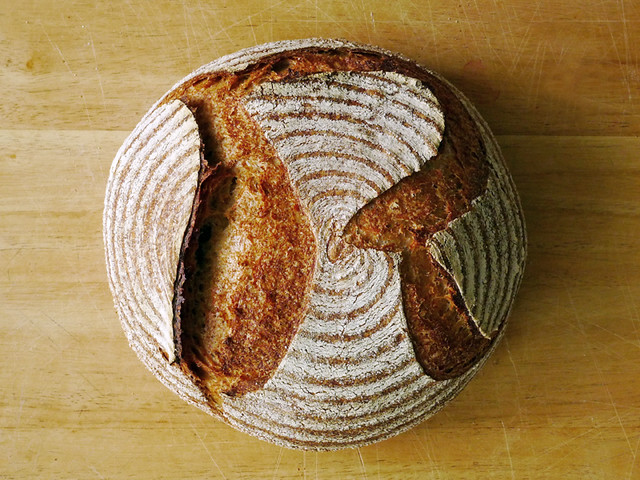 [/url]
[/url]
[url=http://www.flickr.com/photos/67856223@N06/6269500646/]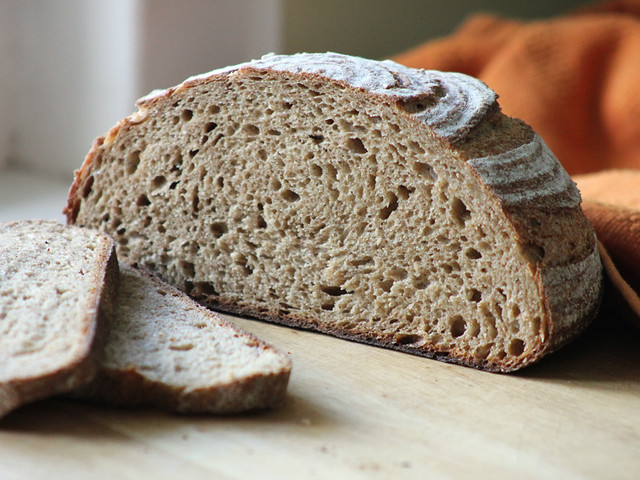 [/url]
[/url]
[url=http://www.flickr.com/photos/67856223@N06/6268975931/]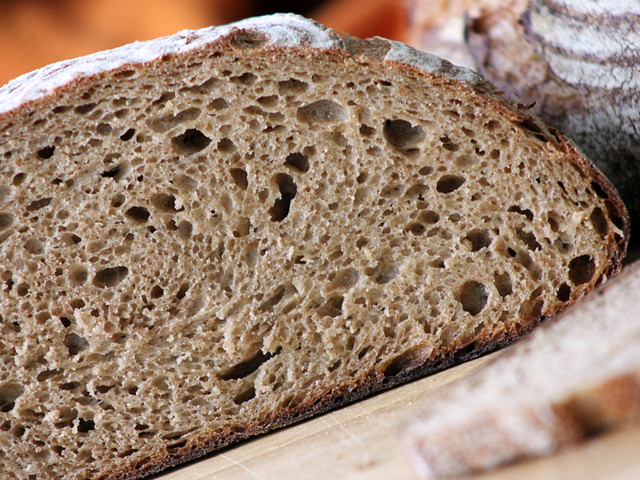 [/url]
[/url]
[url=http://www.flickr.com/photos/67856223@N06/6268975267/]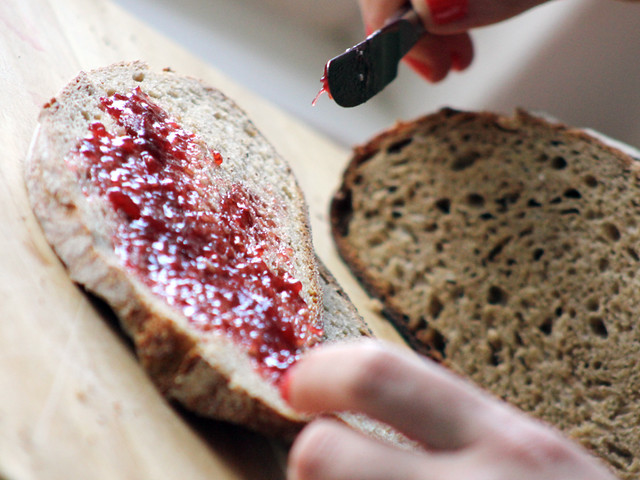 [/url]
[/url]
Cheers, Phil (and the Rat)
- PiPs's Blog
- Log in or register to post comments
Hi Janet,
I purchased the sieve with the mill from Komo. It has a .5mm mesh which I think equates to a 35 in the American standard. Thats not very fine, but Iam not trying to create white flour, just lighten the crumb a little. When I milled the flour this week I used room temperature grains as I had read that cold grains will shatter the bran into smaller pieces. I think it made a small difference. The bran pieces did seem larger and softer.
I often use coarse flour (or add some kibbled grains) in the rye starter. It has time to feed on the flour and time to soften the coarser material which adds some texture to the bread instead of a soaker.
Thanks for the link ... I know it well. :)
Sylvia,
I had to chuckle when I read your line about trying to convince yourself that you NEED a KOMO mill. When I first heard about them I went nuts trying to convince myself that I DIDN'T NEED one....and I didn't as I had a mill already but not like the KOMOs...
My 'wants' won out and I took the plunge this past summer and I am sooooo glad I did because these are really great mills and soooo much easier to use than the one I had before....
Janet
Phil,
Well I finally got the loaf baked - your 2 leaven formula - and I got a picture of it which I will now attempt to post here:
My 4th attempt at sizing this right....proportions are beyond my electronic skills but this will have to do. It was a nice loaf...blurry here but in 'real' life it wasn't :-)
I took some liberties with your formula....I added altus and decreased the water amount for a firmer dough....[When I go too high in hydration I end up with frisbee loaves so I try to keep the HL around 65%-70% so there is room on the bread for my kids to put something on :-) ] I also mixed it in the evening and did the bulk ferment in the refrig. over night with a warm up in the morning before shaping the final loaves....It was then baked on my baking stone with ice cubes added for steam instead of using a DO...
Son, who is my lean dough lover, liked this :-)
A nice loaf to make.
Thanks for posting your formula.
Janet
That looks GREAT Janet,
So glad you tried the formula. How did you find the altus in it? The country bread I made with altus stayed fresh for SO long ... and I mean really fresh. Impressive and tasted fantastic. Yeah, I am using ice cubes as well for steam at the moment ... only so many "round" loaves I can handle in the dutch oven :)
All the best, Phil
Phil,
Loaves here don't stick around too long - a couple of days maybe and all made with sd stay fresh. I have had some last for 5 days when bread consumption drops for other foods.
My son can't describe the difference in loaves when I ask for details (I can't eat the bread I bake so family/friends have to report back to me...). His response, when I ask, goes something like this: "Mom (long sigh because I have asked him no less than a gillion times now....), let me put it to you this way, if I eat it that means I like it. If I don't that means I don't like it." The finer points of bread description elude him....he takes after his dad in that regard.
Be careful with steam - stand back. I steam burned my face about a month ago and didn't realize it until it ended up looking somewhat like an over ripe tomato. Didn't know what inflamed my face in the beginning - thought it was a reaction to a moisturizing lotion - because the initial burn simply didn't hurt. Long story short - ended up being very painful and it became inflamed 3 times over the course of 2 1/2 weeks because I thought is was lotion.....(I burned it once and the following 2 episodes of inflammation were due to me rubbing the lotions off of my face - the abrasion was simply too much for the weakened tissue....)I figured it happened when I poured boiling water into a hot pan in a 500° oven - the pan was on the top rack so nothing between me and it except my face :-/ I am back to ice cubes on a long handled ladle....the bottom of my stove shows the signs but wears them better than my face :-)
Janet